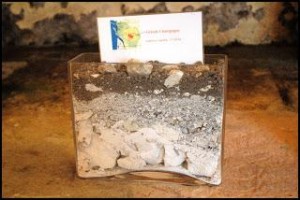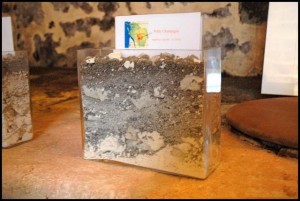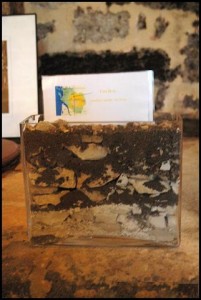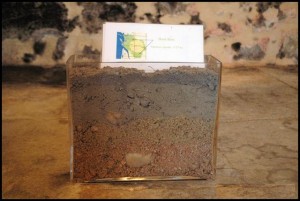Grande Champagne
Grande Champagne is the first Cru and is therefore sometimes called premier cru. It is the second smallest cru. The town of Cognac lies in this cru, but Ségonzac is considered the centre of this cru, even though Segonzac is many times smaller than Cognac.
The soil of Grande Champagne dates back to the Cretaceous period, more precisely the Campanian. The name Champagne (Grande and Petite Champagne) is derived from this.
 The soil is very calcareous and chalky and for this reason, from a quality point of view, it is most suitable for the grapes from which cognac is made. The colour of the soil is often greyish. The cognac from this cru matures very slowly and needs many years to fully develop its bouquet. It can spend up to 50 years in wood, still gaining quality and finesse every year. But after that it has to be transferred into bottles, otherwise the quality deteriorates. Very large bottles, called bonne-bonnes or dame-jeanne’s, are used for this purpose.
The soil is very calcareous and chalky and for this reason, from a quality point of view, it is most suitable for the grapes from which cognac is made. The colour of the soil is often greyish. The cognac from this cru matures very slowly and needs many years to fully develop its bouquet. It can spend up to 50 years in wood, still gaining quality and finesse every year. But after that it has to be transferred into bottles, otherwise the quality deteriorates. Very large bottles, called bonne-bonnes or dame-jeanne’s, are used for this purpose.
In the first years, this cognac has a very sharp taste. Hence, this cognac is not suitable for drinking young.
The cognac is known for its floral character.
The best vineyards of Grande Champage are in the Ségonzac, Juillac-le-Coq, Ambleville, Lignières, Malaville and Bouteville area.
Petite Champagne
The second cru is Petite Champagne. This cru is about twice the size of Grande Champagne and has three main centres: Archiac, Jonzac and Barbezieux. Jonzac lies at the very south of this cru, but is still economically the centre. The soil is slightly firmer and less calcareous. It is somewhat lighter in colour than  the soil of Grande Champagne. Although the quality of the Petite Champagne is slightly less than the Grande Champagne, it is still very good. The cognacs mature a little faster and the flavour is a little fruitier.
the soil of Grande Champagne. Although the quality of the Petite Champagne is slightly less than the Grande Champagne, it is still very good. The cognacs mature a little faster and the flavour is a little fruitier.
Within the Petite Champagne area are two areas with a quality comparable to that of Grande Champagne, namely around Archiac en Arthenac and around Barbézieux.
Borderies
The smallest cru is the Borderies. Here, the soil has lost much of its chalk over time. It is rich in flint and clay. It is brownish in colour.  The cognacs from this region mature more quickly but can age very well. It is widely used by the big cognac houses in the composition of their blends and then contributes to a ‘rounder’ flavour.
The cognacs from this region mature more quickly but can age very well. It is widely used by the big cognac houses in the composition of their blends and then contributes to a ‘rounder’ flavour.
On its own, this cognac is known for its aroma that smells of violets.
Fins Bois
Fins Bois is the largest cru and it lies in a large circle around the first three crus mentioned. There is also a small enclave of Fins Bois in the southwest on the Gironde.
 The soils containing more clay do have quite a bit of variation within this cru; some soils are more sandy, others contain more lime. The colour is often reddish. The cognac from the Fins Bois develops much faster. This is why this cognac often tastes much better than a young cognac from Grande or Petite Champagne.
The soils containing more clay do have quite a bit of variation within this cru; some soils are more sandy, others contain more lime. The colour is often reddish. The cognac from the Fins Bois develops much faster. This is why this cognac often tastes much better than a young cognac from Grande or Petite Champagne.
When the soil is strewn with stones, it is also called groie or terre-de-groie in the fins bois region.
Three fins bois areas are worth a separate mention. In the Southeast around Blanzac, the soil is much more calcareous and here a quality is produced that can very well stand comparison with a Petite Champagne. The region north of Grande Champagne, broadly bounded by Boutiers-St.-Trojan in the West, Sigogne in the North and Moulidars in the East, also produces a very good quality cognac. Third is the region bordering the Gironde west of Mirambeau. This is a fins bois enclave within the bons bois area and it is widely acknowledged that this soil is not inferior to that of petite champagne. Some even go so far as to say it is comparable to grande champagne.
Bons Bois
Like a circle around the Fins Bois lies the Bons Bois. It is moister here and the soil is harder. It cotains clay, sand and limestone and little chalk.  The cognacs that come from here lack finesse. They have a more peasant flavour.
The cognacs that come from here lack finesse. They have a more peasant flavour.
The area to the south of the Fins Bois between La Tâtre and Montguyon forms a narrow corridor where the soil quality is much better.
Bois Ordinaires
Terms also used in the past are Bois Communs and Bois à Terroir. Most of the Bois Ordinaires is located in the West and borders the ocean. The area has a maritime climate and the soils are humid. It also includes the islands of Ile d’Oléron and Ile de Ré.
A small area in the south-east also belongs to the Bois Ordinaires.
The soils are very sandy.
Cognac plays a distinctly lesser role here in economic terms. This can already be seen in the landscape character, as there is much less vineyard planting.
The flavour of these cognacs is also significantly less, sometimes reminiscent of sea, algae and iodine. The cognac does not age well.

Comments
Caracteristics per cru — No Comments
HTML tags allowed in your comment: <a href="" title=""> <abbr title=""> <acronym title=""> <b> <blockquote cite=""> <cite> <code> <del datetime=""> <em> <i> <q cite=""> <s> <strike> <strong>